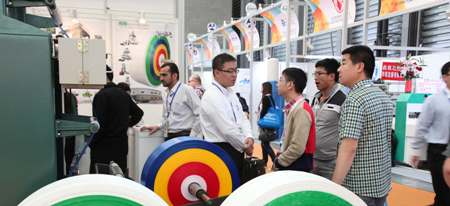The Asia Pacific region has taken on a major role in the global economy. With its strong economic performance, dynamic industrial sector and huge consumer base, the region’s various industries have contributed to the expansion of the global industrial sector.
The International Monetary Fund expects the region’s economy to grow by 6.3% in 2017, a figure that is twice the rate of the global economic growth. Spearheading growth are China with its strategic policy showing positive results, and India which has remained an important investment destination. Member countries of the ASEAN are also fast catching up with the establishment of the ASEAN Economic Community (AEC), a single market of 600 million people that will significantly boost industrial production, trade and services within in the region.
The plastics and rubber industries in the Asia Pacific benefit from the huge investments key industry players are pouring into the region. To date, the region has become the world’s leading plastic additives market due to fast-rising demand as a result of increasing population and improvement in the standard of living. Asia Pacific is also the biggest market for automotive composites with market share seen to reach more than 52% by 2020. The region is seen to account for more than 40% of global demand for packaging products, while demand for thermoformed products is expected to post high growth rates in the next five years. With more than 40% market share, Asia is also now the biggest and fastest growing market for injection molded plastics.
China’s plastics industry on the rise
The plastics industry in China has experienced rapid changes in the past few years, owing to both domestic conditions and international influences. Despite some challenges, China’s resilient plastics industry remains a key driving force in the global industry, and has performed well above expectations. Demand for plastics in the country posted a 10% rise in 2015, a figure that is 1.5 times more than overall GDP growth. Large demand has been noted from such sectors as automotive, electronics/electrical, packaging, medical/healthcare industries where plastics are increasingly replacing traditional materials.
China has been exporting three times more plastics than it imports, and with low manufacturing costs as advantage, the country’s plastics exports will continue to grow. As the country adopts the global trend of using more plastics as part of its lightweighting and environment-friendly strategy, breakthrough technologies and materials are being developed to enable Chinese manufacturers to compete globally. At K 2016, Chinese exhibitors are expected to show off their advanced technologies and materials in support of a global plastics industry that has taken a step forward in sustainability and smart manufacturing.
Taiwan’s remarkable innovations
Taiwan-based companies are expected to show off their innovative spirit at K 2016 when they present their latest products in the area of plastics processing. Taiwan has a highly dynamic plastics machinery sector which supports the growth of the island’s plastics processing industry. Major Taiwan-based companies engaged in providing technologies and equipment have become global players, actively searching to improve the quality of plastics-related exports to meet stiff competition.
Recent developments have paved the way for Taiwan taking a strong position in the development of more advanced technologies in plastics production. For instance, the Plastics Industry Development Center has set up a US$10-million plastics medical research building. The center has also been designated to assist the polymer processing industry in the research and development of more sustainable materials in the areas of composites, 3D printing, aerospace and automotive, functional films and other important sectors. Through more focus on Research and Development (R&D), Taiwan plastics industry aims to transform into a key player for new plastics processing technologies yielding more high quality finished products.
Taiwan’s machine builders are also moving forward to become solutions providers as they aim to offer complete production line, instead of selling a single machine. Thus, more intelligent strategies are being adopted that Taiwan is seeing rising production of high performance servo plastics machineries, automation systems and other cutting-edge technologies that have been contributing to space saving, lower production costs while meeting the demand for sustainable production.

Caption: Asia has a dynamic plastics industry serving various sectors.
ASEAN boosts industrial production
The plastics industry in ASEAN remains unperturbed by global developments that are also impacting the growth path of key industries. Trends and challenges, such as oil prices, variable supply and demand, and weakening of most Asian currencies against the US dollar, have allowed the region’s countries to rediscover their strengths either individually or as a part of the collective grouping of the 10-member ASEAN (Association of Southeast Asian Nation).
ASEAN’s fertile consumer base, with a combined population of over 600 million and a combined GDP of $2.6 trillion as well as presence in the global market, enables the region to tap the right opportunities, hinging on the region’s rising middle class sector. One of ASEAN’s top export sectors by value is plastics and plastic products earned US$39.3 billion in export revenues in 2013. The sector’s production rates have witnessed a steady average growth over the recent years, especially in the ASEAN-6: Indonesia, Malaysia, the Philippines, Singapore, Thailand, and Vietnam, which account for more than 95% of regional GDP, according to McKinsey & Company.
ASEAN member countries are experiencing sustained growth in their plastics industry. Vietnam’s relatively nascent plastics industry had an average annual growth of 16-18% between 2010 and 2015. Packaging accounts for 37.4%, followed by consumer goods (27%), construction (18%) and technical products (15%).
With a population of over 250 million, Indonesia’s government has increased efforts to industrialize and develop the nation towards becoming the world’s 7th largest economy by 2030. Its rising middle class, to double to 141 million people within the next five years, will drive plastics consumption. Malaysia has over 1,500 plastic production companies exporting to various countries around the world. The packaging sector accounts for nearly half of the total plastic consumption market (45%), followed by electronics (26%), automotive (10%) and construction industry (8%). Thailand’s plastic consumption is led by packaging (48%), electronics (15%), construction (14%), and automotive (8%). Its automotive sector attracts manufacturing opportunities, although its overall cost index (i.e. energy, labour, and property) is 20 to 25% higher than Indonesia, Vietnam and the Philippines, largely because of a high quality and mature automotive manufacturing ecosystem, including tiered suppliers of automotive components. Global chemicals hub Singapore offers strong connectivity through shipping routes, a developed infrastructure, manpower capabilities and ease of doing business. Around 95 companies are represented on Singapore’s Jurong Island, attracting investments in excess of S$35 billion, according to the Economic Development Board. Presently, companies like BASF, ExxonMobil Chemical, ARLANXEO, Mitsui Chemicals, Shell and Sumitomo Chemicals have plants in Singapore.














